In our previous blog post we had discussed about Platform Event-Triggered Flow. In these blog post we discuss about Autolaunched Flow in Salesforce
Contents
- 1 Autolaunched Flow in Salesforce
- 2 Benefits of Using Autolaunched Flows
- 3 When to Use Autolaunched Flows
- 4 Creating an Autolaunched Flow
- 5 Best Practices
- 6 Configuring Flow Triggers
- 7 Designing Flow Logic
- 8 Integrating with Other Salesforce Features
- 9 Testing and Debugging Flows
- 10 Deploying Autolaunched Flows
- 11 Monitoring and Maintenance
- 12 Real-World Examples
- 13 Common Challenges and Solutions
- 14 Advanced Tips and Tricks
- 15 Conclusion
- 16 FAQs
- 16.0.0.1 What is the difference between an Autolaunched Flow and a Scheduled Flow?
- 16.0.0.2 Can Autolaunched Flows be triggered by external systems?
- 16.0.0.3 How do you monitor the performance of an Autolaunched Flow?
- 16.0.0.4 What are the limitations of Autolaunched Flows?
- 16.0.0.5 How can I learn more about Salesforce Flows?
Autolaunched Flow in Salesforce
Definition and Purpose
An Autolaunched Flow is a type of Salesforce Flow that runs automatically based on certain conditions or triggers. Unlike Screen Flows, Autolaunched Flows operate in the background without requiring user interaction, making them ideal for automating repetitive tasks.
Differences from Other Flows
The primary distinction between Autolaunched Flows and other types of flows is their automation capability. They are designed to be triggered by specific events, such as record changes or scheduled times, and perform actions without manual initiation.
Benefits of Using Autolaunched Flows
Efficiency and Time-Saving
Autolaunched Flows can significantly reduce the time spent on manual tasks, allowing employees to focus on more strategic activities. By automating repetitive processes, businesses can achieve higher efficiency and productivity.
Error Reduction
Manual processes are prone to human error. Autolaunched Flows help minimize these errors by ensuring consistent execution of tasks, leading to more reliable outcomes.
When to Use Autolaunched Flows
Ideal Scenarios
Autolaunched Flows are perfect for scenarios where tasks need to be performed automatically without user intervention. Examples include updating records, sending notifications, and integrating with external systems.
Business Use Cases
- Lead Assignment: Automatically assign leads to sales representatives based on predefined criteria.
- Data Synchronization: Sync data between Salesforce and external systems at regular intervals.
- Approval Processes: Streamline approval workflows by automating the routing and notification steps.
Creating an Autolaunched Flow
Step-by-Step Guide
Login to Salesforce

Click Gear icon Navigate to Setup
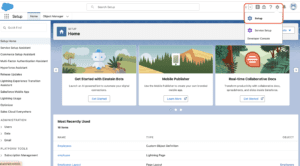
Search Quick Find Box Flow
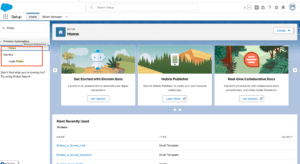
Click New Flow
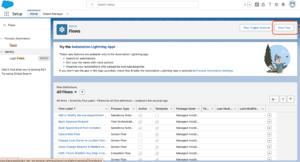
Select Autolaunched Flow
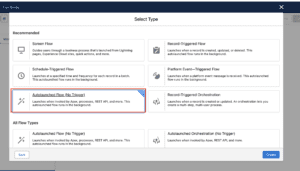
Select add elements
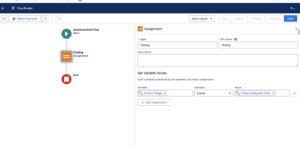
Setup Conditions trigger
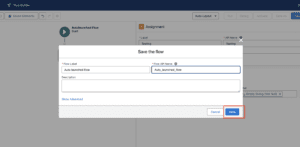
Save And Activate
Best Practices
- Plan Your Flow: Outline the process and identify the required elements before building the flow.
- Use Descriptive Names: Name elements and variables clearly to make the flow easy to understand.
- Test Thoroughly: Test the flow in a sandbox environment to ensure it works as expected.
Configuring Flow Triggers
Triggering Flows with Events
Autolaunched Flows can be triggered by various events, such as record creation, updates, or deletions. Configure these triggers to define when the flow should run.
Scheduled Flows
In addition to event triggers, Autolaunched Flows can be scheduled to run at specific times. This is useful for tasks that need to occur regularly, such as daily data backups.
Designing Flow Logic
Decision Elements
Use decision elements to create branching logic within your flow. This allows the flow to take different actions based on specified conditions.
Loop Elements
Loop elements enable the flow to iterate over a collection of records and perform actions on each one. This is particularly useful for bulk data processing.
Integrating with Other Salesforce Features
Using Apex with Autolaunched Flows
For more complex logic, Autolaunched Flows can be integrated with Apex code. This allows you to extend the functionality of your flows by leveraging Salesforce’s powerful programming language.
Integrating with Process Builder
Autolaunched Flows can be used in conjunction with Process Builder to create more sophisticated automation workflows. Process Builder can trigger Autolaunched Flows based on record changes, combining the strengths of both tools.
Testing and Debugging Flows
Methods for Testing
Testing is crucial to ensure your flow operates correctly. Use Salesforce’s built-in debugging tools to test your flow and identify any issues.
Common Debugging Tips
- Check Flow Logs: Review the flow logs to trace the execution path and identify errors.
- Use Debug Mode: Run the flow in debug mode to step through each element and observe the flow’s behavior.
- Validate Data: Ensure that the input data meets the flow’s requirements.
Deploying Autolaunched Flows
Best Practices for Deployment
- Use Change Sets: Deploy flows using change sets to move them from sandbox to production environments.
- Monitor Performance: Keep an eye on the flow’s performance and optimize it as needed.
- Document Changes: Maintain detailed documentation of flow changes and updates.
Monitoring and Maintenance
Regularly monitor your Autolaunched Flows to ensure they continue to perform as expected. Update flows as business requirements change and Salesforce releases new features.
Real-World Examples
Case Studies
- Customer Support: A company used Autolaunched Flows to automatically assign support cases to the appropriate teams based on case type and priority.
- Marketing Automation: An organization integrated Autolaunched Flows with their marketing platform to automatically sync lead data and trigger personalized email campaigns.
Industry Applications
Autolaunched Flows are used across various industries, including healthcare, finance, and retail, to streamline operations and improve efficiency.
Common Challenges and Solutions
Troubleshooting Tips
- Flow Errors: Identify and fix flow errors by reviewing error messages and flow logs.
- Performance Issues: Optimize flow performance by simplifying logic and reducing the number of elements.
Avoiding Common Pitfalls
- Overcomplicating Flows: Keep flows as simple as possible to ensure they are easy to maintain and debug.
- Lack of Testing: Thoroughly test flows before deploying them to production to avoid unexpected issues.
Advanced Tips and Tricks
Optimization Techniques
- Minimize DML Operations: Reduce the number of data manipulation language (DML) operations to improve flow performance.
- Use Subflows: Break complex flows into smaller subflows to make them more manageable.
Leveraging Salesforce Updates
Stay informed about the latest Salesforce updates and features to continuously improve your Autolaunched Flows. Salesforce regularly releases enhancements that can simplify and enhance flow functionality.
Conclusion
Autolaunched Flows are a powerful tool in Salesforce, enabling businesses to automate complex workflows and improve efficiency. By understanding how to create, configure, and deploy these flows, you can harness their full potential to drive your organization’s success. Keep experimenting with different use cases and stay updated with Salesforce innovations to keep your automation strategies ahead of the curve.
We Want to more about What is Autolaunched flow Click Here
FAQs
What is the difference between an Autolaunched Flow and a Scheduled Flow?
Autolaunched Flows can be triggered by events or run automatically in response to specific conditions, while Scheduled Flows run at predefined times.
Can Autolaunched Flows be triggered by external systems?
Yes, Autolaunched Flows can be triggered by external systems using Salesforce APIs or integration tools.
How do you monitor the performance of an Autolaunched Flow?
Monitor the performance of an Autolaunched Flow using Salesforce’s flow logs, performance monitoring tools, and by regularly reviewing and optimizing the flow logic.
What are the limitations of Autolaunched Flows?
Limitations include complexity in debugging, potential performance issues with large data volumes, and the need for careful planning to avoid overcomplicating flows.
How can I learn more about Salesforce Flows?
To learn more about Salesforce Flows, explore Salesforce’s official documentation, participate in Salesforce Trailhead modules, and join Salesforce community forums and user groups.
In our next blog post we will discuss about Record-Triggered Orchestration Flow

2 thoughts on “Autolaunched Flow in Salesforce”